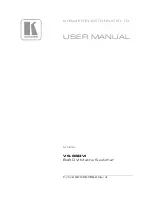
Chapter 4 Switch Installation S7800 Series Hardware Installation Guide
25
4.11
Connecting the External
Interface Cables
4.11.1
Precautions
n
Correctly distinguish single-mode and multi-mode fibers and ports.
n
Avoid bends of small radius at the connector.
4.11.2
Simple Connection Steps
1. Connect one end of the RJ45 connector for configuring Ethernet cables to the Ethernet
interface of the device board and the other end to the NMS or a control terminal; or
connect one end of the standard RJ45 serial port cable to the serial port of the device
board and the other end to the NMS or a control terminal.
2. Insert the single-mode or multi-mode fiber into the appropriate interface according to
the identification on the panel of the linecard. Distinguish the Rx/Tx end of the fiber.
3. Insert the twisted pair with the RJ45 port into the appropriate interface according to the
identification on the panel of the linecard. Distinguish the crossover cable and
straight-through cable.
4. Connect the cables and fibers of each board in sequence.
4.12
Binding the Cables
4.12.1
Precautions
n
The power cables and other cables should be bound in a visually pleasing way.
n
When you bind fibers, be sure that the fibers at the connectors have natural bends or
bends of large radius.
n
Do not bind fibers and twisted pairs too tightly, as this may press hard the fibers and
affect their useful life and transmission performance.
4.12.2
Simple Binding Steps
1. Bind the drooping part of the fibers and twisted pairs of each board, and lead them to
both sides of the chassis for convenience.
2. On the both sides of the chassis, fasten the fibers or twisted pairs to the cabinet cable
management ring or cabling chute.
3. For the power cables, you should bind them closely along the bottom of the chassis, in
a straight line wherever possible.
4.13
Installation Verification
4.13.1
Verifying the Cabinet
n
Verify if the external power supply matches the distribution panel of the cabinet.
















































